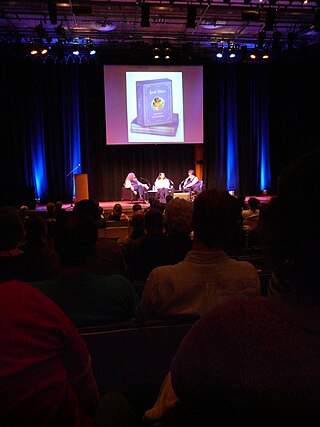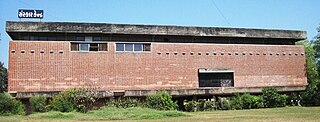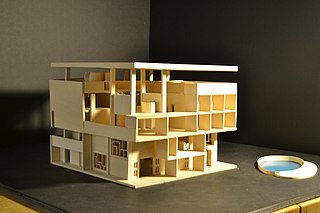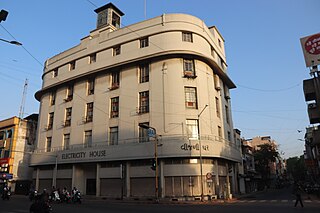
The Queen Elizabeth Hall (QEH) is a music venue on the South Bank in London, England, that hosts classical, jazz, and avant-garde music, talks and dance performances. It was opened in 1967, with a concert conducted by Benjamin Britten.

The Purcell Room is a concert and performance venue which forms part of the Southbank Centre, one of central London's leading cultural complexes. It is named after the 17th century English composer Henry Purcell and has 370 seats. The Purcell Room has hosted a wide range of chamber music, jazz, mime and poetry recitals. In the context of the Southbank Centre it is the smallest of a set of three venues, the other two being the Royal Festival Hall, a large symphony hall, and the Queen Elizabeth Hall (QEH), which is used for orchestral, chamber and contemporary amplified music.

Balkrishna Vithaldas Doshi OAL was an Indian architect. He is an important figure in Indian architecture and noted for his contributions to the evolution of architectural discourse in India. Having worked under Le Corbusier and Louis Kahn, he was a pioneer of modernist and brutalist architecture in India.

The Perth Concert Hall is a concert hall located in Perth, the capital of the Australian state of Western Australia. Owned by the City of Perth, the hall is the main venue of the West Australian Symphony Orchestra, and also hosts a number of other events and performances. The building itself is located in Perth's central business district, adjacent to the Supreme Court Gardens and Government House. The building has two façades: facing north over St Georges Terrace, and facing south over the Swan River.

The Moti Shahi Mahal is a palace built by the Mughal emperor Shahjahan between 1618 and 1622. It now hosts the Sardar Vallabhbhai Patel National Memorial, which is a museum and exhibition centre dedicated to Vallabhbhai Patel located in Shahibaug, Ahmedabad, Gujarat, near Civil Hospital, Ahmedabad. It is surrounded by well laid gardens.

Sanskar Kendra is a museum at Ahmedabad, India, designed by the architect Le Corbusier. It is a city museum depicting history, art, culture and architecture of Ahmedabad. Another Patang Kite Museum is there which includes a collection of kites, photographs, and other artifacts. The campus is located at the west end of Sardar Bridge near Paldi.

According to the 2011 national census, the population of Ahmedabad was declared to be 7,214,225. This figure was only limited to the municipality region. The total population of the Ahmedabad Urban Agglomeration came to 7.2 million people. There were 886 females to every 1000 males in 2001. Now there are 904 women to 1000 men in 2011. Ahmedabad had a literacy rate of 79.89% in 2001 which rose to 89.62 percent in 2011. Out of this, male and female literacy are 93.96 and 84.81 percent as of 2011 census. According to the census for the ninth plan, there are 30737 rural families living in Ahmedabad. Out of those, 5.41% live below the poverty line. There are 439,843 people who live in slums in the city. The majority of residents of Ahmedabad are native Gujaratis and speak Gujarati. There is also a sizable population of Punjabis, Marathis, Tamils, Sindhis, Malayalis and Marwaris who bring in their native language and culture to the city. The government institutions and military base near the city also bring peoples from across India. The city's population has increased in a major way following increasing economic expansion and modernization.
Paldi is an area located in South Western Ahmedabad, India. Corporate offices and city centres of many national and international companies like ICICI Bank, Royal Bank of Scotland, Religare, Claris, Gujarat Gas are located within Paldi. It accommodates Sanskar Kendra museum by the renowned architect Le Corbusier as well as Tagore Memorial Hall. The National Institute of Design is located in Paldi. M K Gandhi's first ashram in India, Kochrab Ashram is also located in Paldi. This area has many houses of the Art Deco period.

Mill Owners' Association Building, also known as Ahmedabad Textile Mill Owners' Association House, is a modern architecture building in Ahmedabad, India designed by Swiss-French architect Le Corbusier.

Government Museum and Art Gallery, Chandigarh, is a premier museum of North India having collections of Gandharan sculptures, sculptures from ancient and medieval India, Pahari and Rajasthani miniature paintings. It owes its existence to the partition of India in August, 1947. Prior to the partition, much of the collections of art objects, paintings and sculptures present here were housed in the Central Museum, Lahore, the then capital of Punjab. The museum has one of the largest collection of Gandharan artefacts in the world.

Jhaverchand or Zaverchand Kalidas Meghani was an Indian poet, writer, social reformer and freedom fighter. He is a well-known name in the field of Gujarati literature. He was born in Chotila where the Government College has been renamed for this literary figure as Raashtreeya Shaayar Zaverchand Meghani College, Chotila. Mahatma Gandhi spontaneously gave him the title of Raashtreeya Shaayar. Besides this he received many awards like Ranjitram Suvarna Chandrak and Mahida Paaritoshik in literature. He authored more than 100 books. His first book was a translation work of Rabindranath Tagore's called Kathaa-u-Kaahinee titled Kurbani Ni Katha which was first published in 1922. He contributed widely to Gujarati folk literature. He went from village to village in search of folk-lores and published them in various volumes of Saurashtra Ni Rasdhar. He was also the Editor of Phulchhab Newspaper of Janmabhoomi group.

Villa Shodhan is a modernist villa located in Ahmedabad, India. Designed by the Swiss architect Le Corbusier, it was built between 1951 and 1956. Building on his previous projects whilst integrating the traditional features of Ahmedabad design, the villa symbolizes Le Corbusier's domestic architecture. The building is currently used as a private residence.

The Hayward Gallery is an art gallery within the Southbank Centre in central London, England and part of an area of major arts venues on the South Bank of the River Thames. It is sited adjacent to the other Southbank Centre buildings and also the National Theatre and BFI Southbank repertory cinema. Following a rebranding of the South Bank Centre to Southbank Centre in early 2007, the Hayward Gallery was known as the Hayward until early 2011.
Chinubhai Chimanlal also commonly referred to as Chinubhai Mayor was industrialist, cotton textile mill owner and one of the scions of Lalbhai group. He was elected as first mayor of Ahmedabad Municipal Corporation.
The Architecture of Gujarat consists of architecture in the Indian state of Gujarat.

The Ahmedabad Town Hall, officially Sheth Mangaldas Girdhardas Memorial Hall, is an auditorium in Ahmedabad, India. It is named after Mangaldas Girdhardas, a textile industrialist.

The Palika Kendra is a 21-story building on Sansad Marg, New Delhi, India. Designed by Kuldip Singh and Mahendra Raj, it is among the few structures in Delhi that feature Brutalist architecture. After its inauguration in 1984 with a height of 91 metres (299 ft), it remained one of the tallest buildings in Delhi for years. It serves as the headquarters of the New Delhi Municipal Council and hosts the main server and the command and control centre of the civic body.
The Maison de la Culture de Firminy is a cultural establishment located in Firminy in the Loire region of France. The site was inscribed on the UNESCO World Heritage List in 2016 for its contribution to the development of modern architecture along with sixteen other works by Le Corbusier.

Vijali Ghar, also known as Electricity House, is an office building on Relief Road, Ahmedabad, Gujarat, India. It is an Art Deco building designed by Claude Batley.
Mahendra Raj was an Indian structural engineer and designer who contributed to structural design of many buildings in India including the Hall of Nations at the Pragati Maidan in Delhi and the Salar Jung Museum in Hyderabad. Raj's work is considered pioneering for its engineering solutions for exposed concrete buildings and much of his work is seen as telling the history of post-independence India. In a career spanning six decades, he collaborated with architects including Le Corbusier, B. V. Doshi, Charles Correa, and Raj Rewal, and contributed to the structural design for more than 250 projects.

















